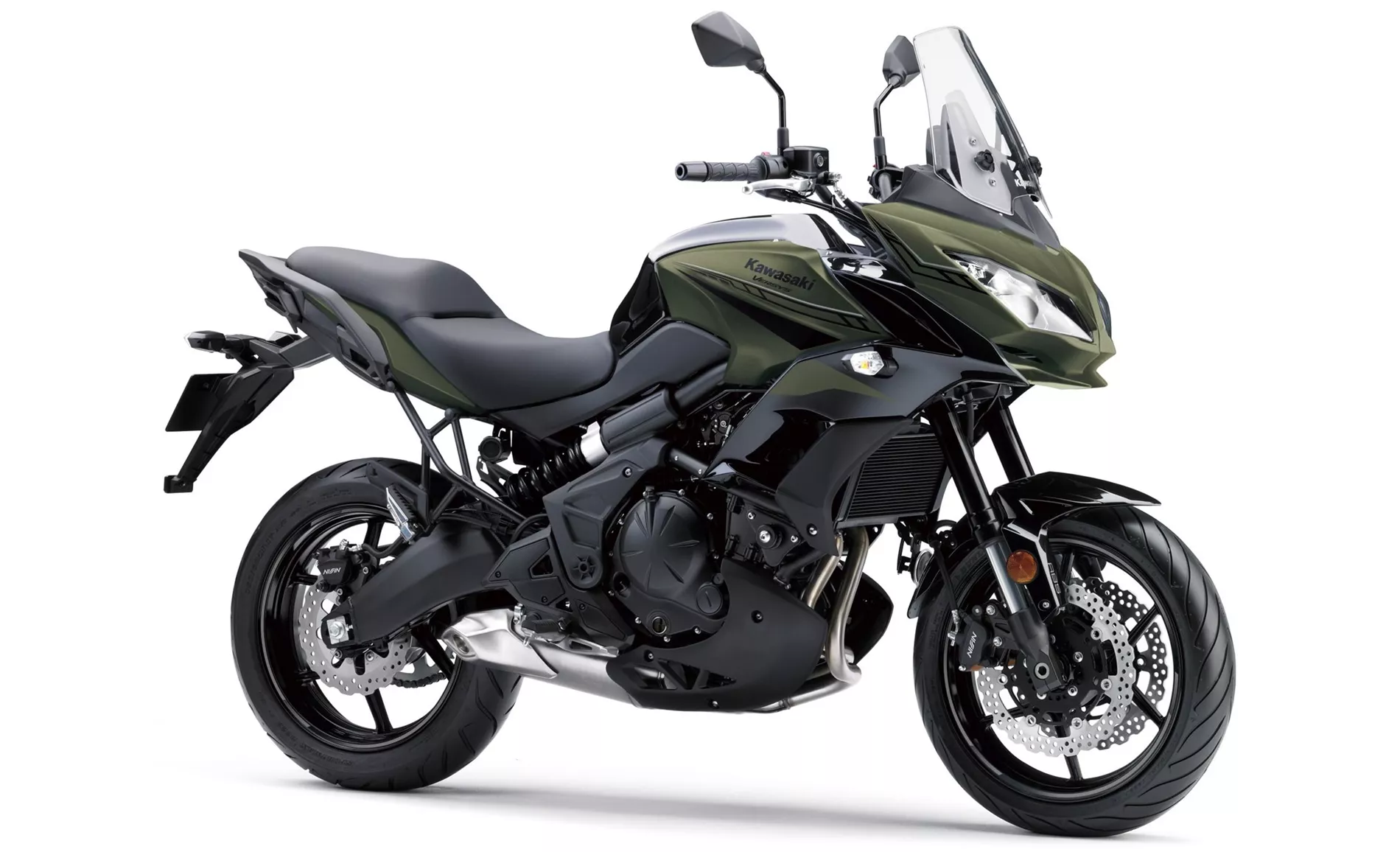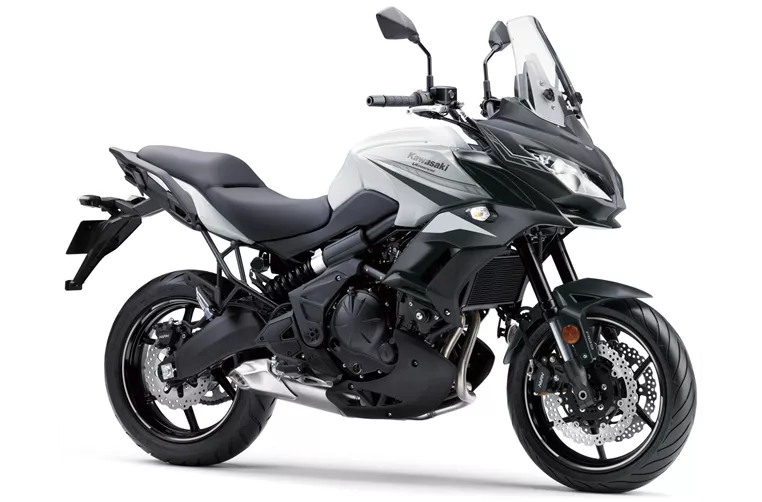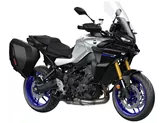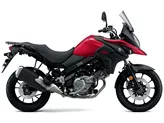Kawasaki Versys 650 2020 vs. Kawasaki Versys 1000 SE 2020

Kawasaki Versys 650 2020

Kawasaki Versys 1000 SE 2020
Overview - Kawasaki Versys 650 2020 vs Kawasaki Versys 1000 SE 2020
The Kawasaki Versys 650 2020 and the Kawasaki Versys 1000 SE 2020 are both enduro motorcycles that offer different features and capabilities.
Starting with the engine and drive train, both models have an inline engine type. However, the Versys 650 has a larger bore of 83 mm compared to the Versys 1000 SE's 77 mm. The stroke of the Versys 650 is also larger at 60 mm compared to the Versys 1000 SE's 56 mm. In terms of power, the Versys 1000 SE has a significant advantage with 120 HP compared to the Versys 650's 69 HP. The torque of the Versys 1000 SE is also higher at 102 Nm compared to the Versys 650's 64 Nm. Both models have an electric starter and a chain transmission. The Versys 650 has 2 cylinders and a displacement of 649 ccm, while the Versys 1000 SE has 4 cylinders and a displacement of 1043 ccm.
In terms of suspension, both models feature upside-down telescopic forks at the front. The Versys 650 has rebound adjustment, while the Versys 1000 SE has additional compression and preload adjustment. Both models have rebound adjustment for the rear suspension.

Kawasaki Versys 650 2020
In terms of chassis, the Versys 650 has a steel frame, while the Versys 1000 SE has an aluminum frame. This makes the Versys 1000 SE lighter and potentially more agile.
Both models have double disk brakes at the front. The front tire diameter is 17 inches for both models. The rear tire width is 160 mm for the Versys 650 and 180 mm for the Versys 1000 SE. The rear tire diameter is 17 inches for both models.
In terms of dimensions and weights, the Versys 1000 SE has a longer wheelbase of 1520 mm compared to the Versys 650's 1415 mm. Both models have a seat height of 840 mm. The kerb weight with ABS is higher for the Versys 1000 SE at 257 kg compared to the Versys 650's 216 kg. Both models have a fuel tank capacity of 21 liters.

Kawasaki Versys 1000 SE 2020
Now, let's discuss the strengths and weaknesses of each model. The Versys 650 offers great travel comfort and has a pleasant and comfortable chassis. It is easy to use and has a seating position ready for touring. The Versys 650 also offers agile and light-footed handling. However, it has some weaknesses such as vibrations in the footpegs, response behavior during the transition from pushing and load operation, and the inability to deactivate ABS. The weight of the Versys 650 is also somewhat high.
On the other hand, the Versys 1000 SE offers high riding comfort for both the rider and passenger. It provides great wind and weather protection, making it suitable for long rides. The high-quality chassis of the Versys 1000 SE can be adjusted very precisely to meet the rider's requirements. The engine of the Versys 1000 SE is well controllable and rev-happy, providing a strong pull. However, the Versys 1000 SE has some weaknesses, including an oversized windshield that reduces wind flow even at the lowest setting, and a display and mobile phone app that cannot keep up with the competition.
In conclusion, the Kawasaki Versys 650 2020 and the Kawasaki Versys 1000 SE 2020 are both capable enduro motorcycles with their own strengths and weaknesses. The Versys 650 offers great travel comfort and agility, while the Versys 1000 SE provides high riding comfort and a powerful engine. Depending on the rider's preferences and requirements, either model can be a suitable choice.
Technical Specifications Kawasaki Versys 650 2020 compared to Kawasaki Versys 1000 SE 2020
Pros and Cons in comparison
Pros and Cons in comparison
Kawasaki Versys 650 2020

The 2019 model year Kawasaki Versys presented itself as a comfortable, stable yet lively touring machine. The motorbike is versatile and offers high utility value. It is a fully-fledged touring machine that is a pleasure to ride on extended tours. The bike offers a terrific price/performance ratio.
Kawasaki Versys 1000 SE 2020

The Kawasaki Versys 1000 SE is a particularly well-designed representative of a type that is so difficult to categorise. In the end, it is simply a very good and universal motorbike. At the regulars' table, it will hardly score points with 120 hp. But in practice, all elements of the motorbike are designed and dimensioned in such a way that you enjoy riding it for a long time. On long tours, it has sufficient power, offers dynamic handling and high riding comfort. Compared to the competition, you hardly miss the power. Kawasaki should improve on the integration of a Navigatinos app in the display.
Price Comparison Avarage Market Price Kawasaki Versys 650 vs Kawasaki Versys 1000 SE
There are a few key differences between a Kawasaki Versys 650 2020 and a Kawasaki Versys 1000 SE 2020. In terms of price, the actual average price of a Kawasaki Versys 1000 SE 2020 is about 102% higher. Compared to Kawasaki Versys 1000 SE 2020 there are more Kawasaki Versys 650 2020 bikes available on the 1000PS.de Marketplace, specifically 11 compared to 8. It takes less time to sell a Kawasaki Versys 650 with 137 days compared to 156 days for a Kawasaki Versys 1000 SE. Since model year 2007 1000PS.de editors have written 39 reviews for the Kawasaki Versys 650 and 12 reviews for the Kawasaki Versys 1000 SE since model year 2019. The first review for the Kawasaki Versys 650 was published on 7/25/2006 and now has more than 3,900 views. This compares to more than 25,500 views for the first review on Kawasaki Versys 1000 SE published on 11/6/2018.






















